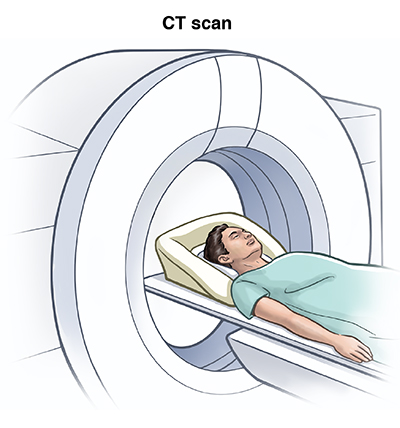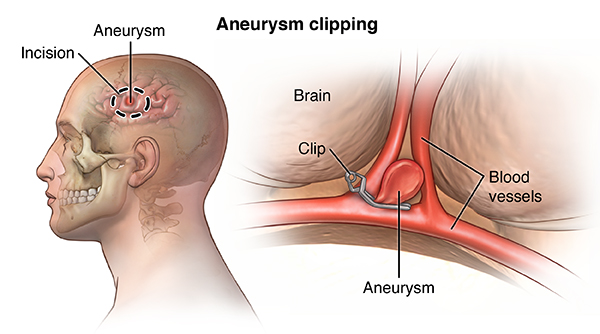How a Cerebral Aneurysm is Diagnosed and Treated
How is a Cerebral Aneurysm Diagnosed?
A cerebral aneurysm is often found after it has ruptured. Or it's found by chance during an imaging test for headaches or other reasons.
Your healthcare provider will ask about your health history. He or she will give you a physical exam. You may also need tests such as:
Cerebral Angiography
This test makes an image of the blood vessels in the brain to help locate problems with vessels and blood flow. The procedure is done by putting a thin tube (catheter) into an artery in the leg. The tube is passed up to the blood vessels in the brain. Contrast dye is injected through the catheter and X-ray images are taken of the blood vessels.
CT Scan
This test uses X-rays and a computer to make detailed images of the body. A CT scan shows details of the bones, muscles, fat, and organs. CT scans are more detailed than general X-rays. It may be used to help show the location of the aneurysm and if it has burst or is leaking. A CT angiogram (CTA) can also be done with a CT scan to look at the blood vessels.

MRI
This test uses large magnets, radio waves, and a computer to make detailed images of organs and tissues in the body. An MRI uses magnetic fields to see small changes in brain tissue. This can help to find and diagnose an aneurysm.
Magnetic Resonance Angiography (MRA)
This is a noninvasive test that uses an MRI and IV (intravenous) contrast dye to show blood vessels. Contrast dye causes blood vessels to look opaque on the MRI image. This helps the doctor to see the blood vessels more clearly.
How is a Brain Aneurysm Treated?
The main goal during treatment is to decrease the risk of bleeding in the brain. Many factors are considered when making treatment choices. These include:
- The size and location of the aneurysm
- If you have symptoms
- Your age and overall health
- If you have risk factors for aneurysm rupture
In some cases, the aneurysm may not be treated. You may instead be closely watched by your healthcare provider over time. In other cases, surgery may be needed.
There are two main types of surgery for a cerebral aneurysm. They are:
Open Craniotomy (Surgical Clipping)
This procedure is done by removing part of the skull to reach the aneurysm. The surgeon places a metal clip across the neck of the aneurysm. This is done to prevent blood flow into the aneurysm bulge. Once the clipping is done, the skull is closed back together.

Endovascular Coiling
This is also called coil embolization. It is a minimally invasive method and is the most common method used to treat cerebral aneurysms. An incision in the skull is not needed. Instead, a catheter is pushed up from a blood vessel in the groin into the blood vessels in the brain. Fluoroscopy (live X-ray) is used to help move the catheter into the head and aneurysm.
Once the catheter is in place, tiny platinum coils are put through the catheter into the aneurysm. These soft coils are visible on an X-ray and conform to the shape of the aneurysm. The coiled aneurysm becomes clotted off (embolization) and this prevents rupture.
This procedure is done with general anesthesia, sedation, or local anesthesia. Your surgeon can help you decide which option is best for you.
What are Possible Brain Aneurysm Complications?
Bleeding
Bleeding is usually around the brain. An aneurysm can also bleed in the brain and in the cerebral ventricles. Bleeding is life-threatening.
Rebleeding
The second bleed is often worse than the first. Because of this, early treatment is vital after the first bleed.
Vasospasm
This is the narrowing of the cerebral arteries. It usually occurs 3 to 14 days after an aneurysm has bled. It can lead to strokes and death. This problem happens in up to half of people who had an aneurysm bleed, even if the bleed was treated.
Hydrocephalus
This is fluid buildup on the brain. It is caused by cerebrospinal fluid (CSF) that is not reabsorbed normally.
Compression of the Brain or Cranial Nerves
This can lead to some nervous system problems including eye movement paralysis.
Reoccurrence
Some aneurysms can happen again after being treated.